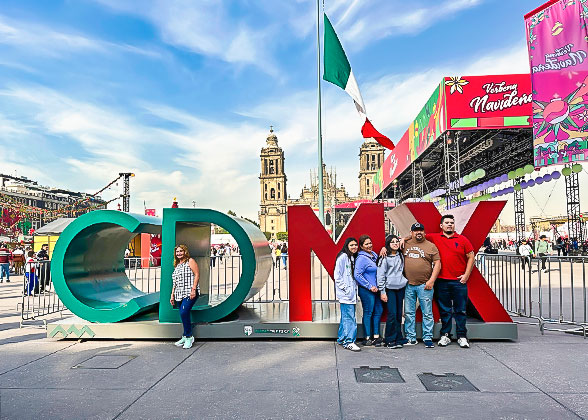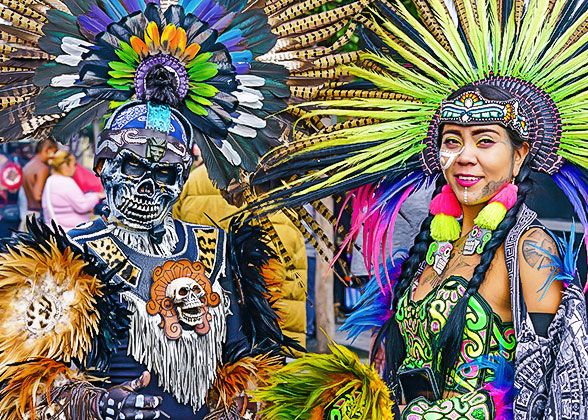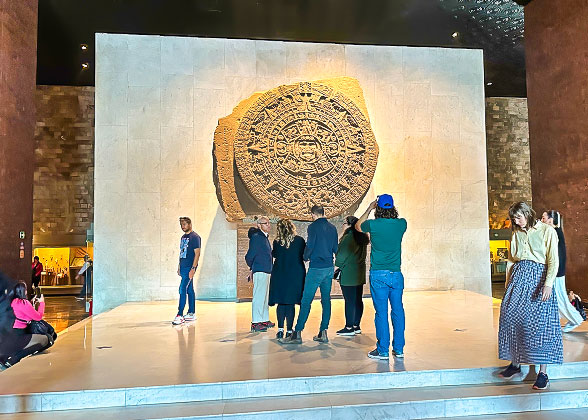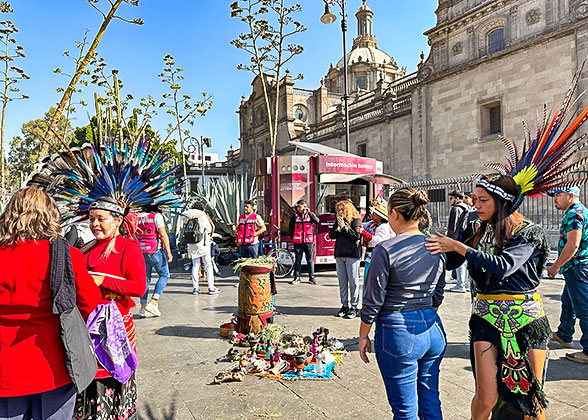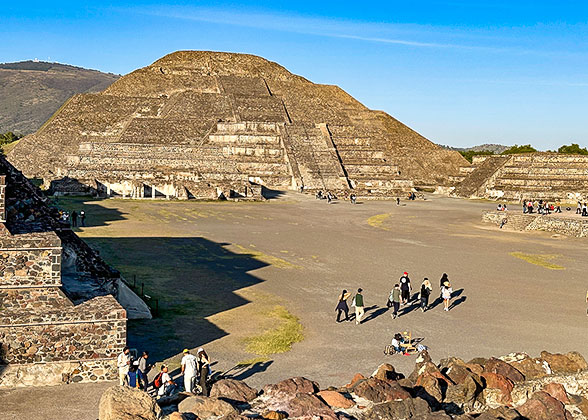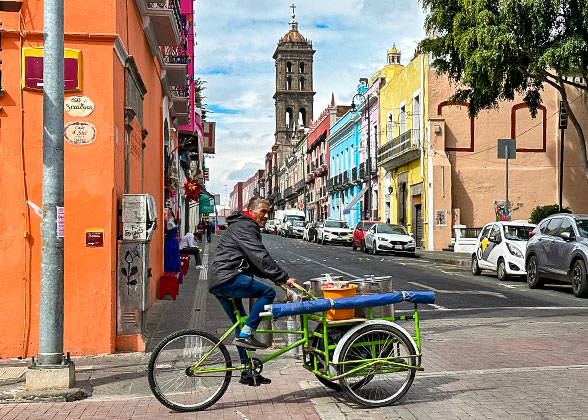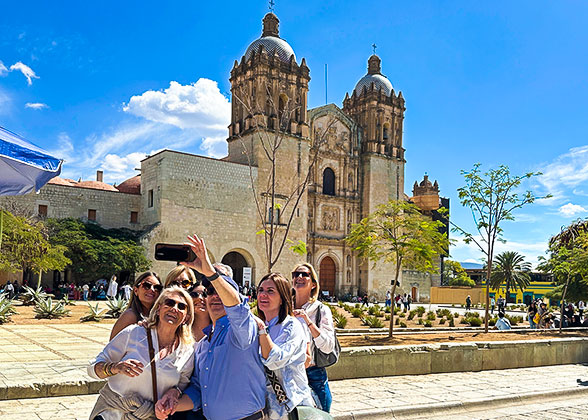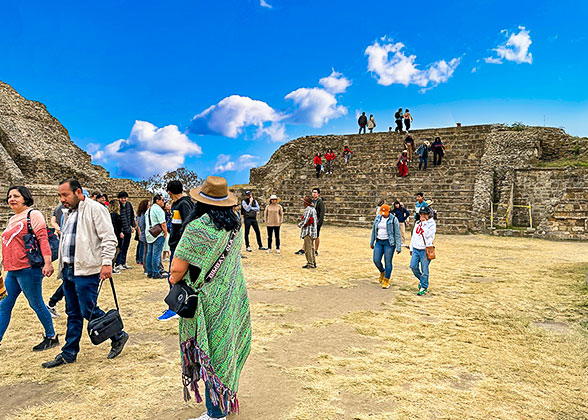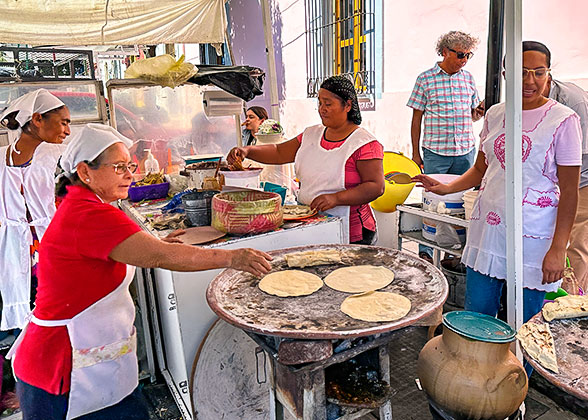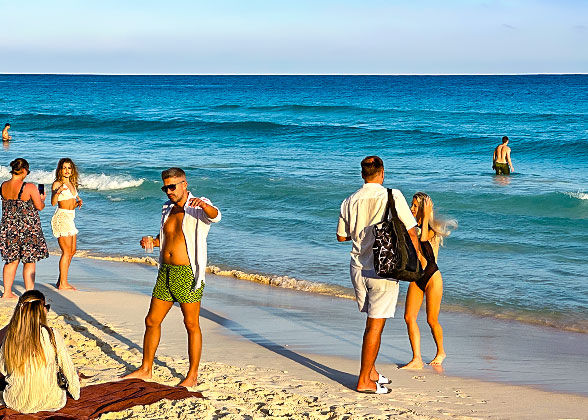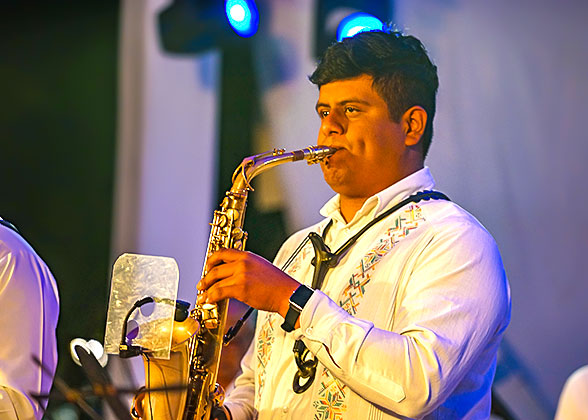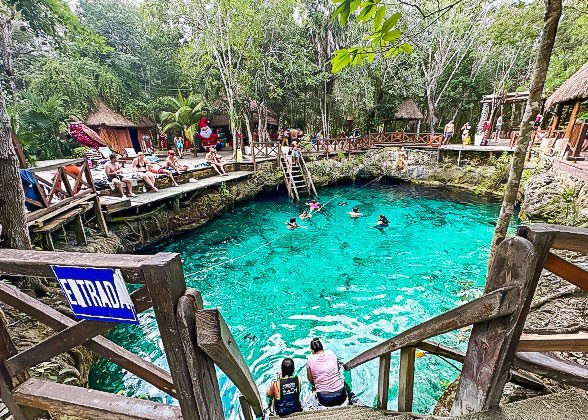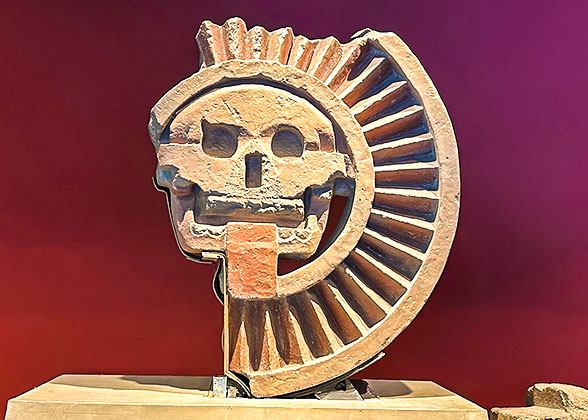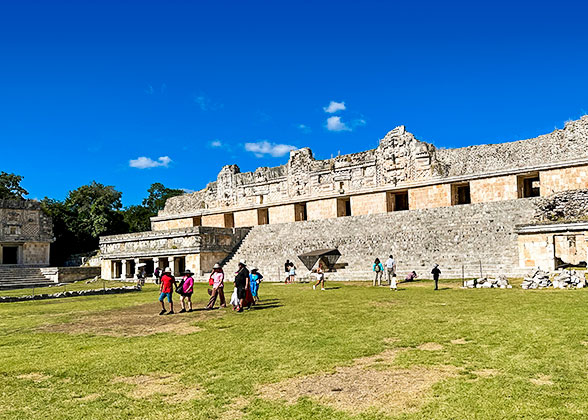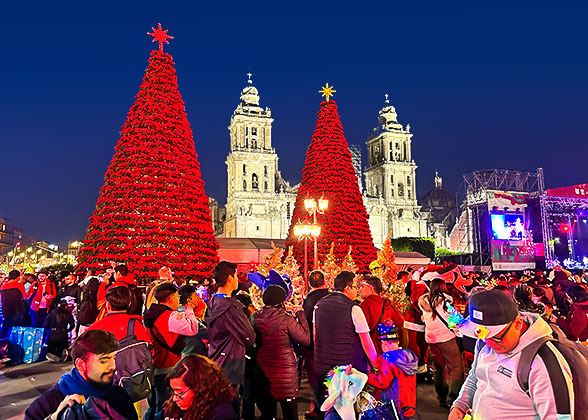Day 1: Mexico City Airport Pick-up
Get ready to embrace the vibrancy of Mexico, where ancient Indian culture, Mayan and Aztec echoes, and the world’s top beach resorts converge. Your adventure begins in Mexico City, where our English-speaking guide greets you at the airport. Hop aboard our well-prepared private car for a smooth chauffeur-driven journey to your hotel. Unwind, or explore the surroundings at your own pace. Accommodation: Historico Central Hotel, Mexico City (4 stars) - Deluxe Room or similar Free Time Suggestions:Our handpicked hotel nestled within the historic center offers a perfect base for exploration. Feeling energized? Just start a familiarizing city walk. Stroll along the Av. 5 de Mayo, soaking in the bustling vibe of the roadside cafes and the grandeur of historic buildings. Within a 10-minute walk, you’ll reach the iconic Latin American Tower (Torre Latinoamericana). Ascend to its observation deck, and be swept away by breathtaking panoramas. Picture the majestic Palace of Fine Arts and Alameda Central Park laid out before you. As twilight descends, witness the city’s transformation into a glittering tapestry of lights. ★ Insider Tips:1. Visa: Mexico offers visa-free entry for citizens of 69 countries. Travelers who hold a valid visa from a Schengen country, the United States, Canada, the United Kingdom, or Japan can also enter Mexico without a visa for a stay of up to 180 days. If you’re unsure whether you need a visa, please contact us for the latest information. 2. Currency Exchange: While mobile payment is gaining traction, cash and card payments are still the primary methods in Mexico. Most stores and restaurants accept credit card payment. It is recommended to exchange some Mexican pesos (MXN) before your trip. The approximate exchange rate is USD 1 ≈ MXN 17 (as of February 2024). Here are some tips for getting the best rates: a. Avoid airport currency exchange: Rates are usually unfavorable. Change only a small amount if needed. b. Skip hotel currency exchange: They tend to have lower rates than other options. c. Look for Casas de Cambio (exchange bureaus): Compare rates before exchanging. d. Use ATMs: The exchange rate for withdrawing cash with credit or debit cards is often good. However, be aware of ATM fees and limited availability in remote areas. 3. Communication and Internet: Telcel SIM card offers the most extensive coverage and is recommended for its convenience. Get a card for 79 pesos and a 30-day plan for 200 pesos with 3GB of data. It’s plug-and-play and works throughout Mexico with continued use in the US or Canada after roaming. Purchase it at Telcel shops or OXXO convenience stores and get it activated by a clerk or your tour guide.
|
Day 2: Mexico City: National Museum of Anthropology & Historic Center Walk
Mexico City: National Museum of Anthropology This morning, prepare to be dazzled by ancient wonders at the National Museum of Anthropology (Museo Nacional de Antropologia), the most visited museum in Mexico. While the museum’s sheer size might feel overwhelming, with a professional guide, you’ll easily get to the point. Focus on the first floor, where archaeological finds tell the stories of pre-Columbian heritage, including iconic artifacts from the Olmec, Toltec, Aztec, Teotihuacan, and Mayan civilizations. The second floor displays a kaleidoscope of diverse cultures, art, religion and lifestyle of ethnic groups in Mexico through costumes, musical instruments, weapons, and living utensils. Four Things to Know:1. Focus on Galleries 5 to 10: Discover the museum’s crown jewels, including the Stone of the Sun (or Aztec Calendar Stone), Xochipilli Statue, and the Cacaxtla Mural - Bird Man. 2. Comfy Shoes are Essential: With a total route of around 5 km, exploring the museum requires sufficient physical strength and right footwear. 3. Capture the Memories: Photos are allowed in the exhibition halls, but remember to leave the flash off. 4. If it falls on a Monday when the museum is closed, we will swap for a trip to the Soumaya Museum and Museum of Tequila and Mezcal. In the afternoon, let’s walk through the historic Spanish-style buildings of the Old Town, where we will find the core of Mexican culture wrapped in colonial architecture. Wander through the vast Zocalo (Plaza de la Constitución) to admire the majestic Metropolitan Cathedral (Catedral Metropolitana de la Ciudad de México) that stands next to it. See the exterior of Templo Mayor Museum (Museo del Templo Mayor) and sigh over the remnants of a 14th-century Aztec temple destroyed by the Spanish visitors. Next, visit the National Palace (Palacio Nacional) on the east side of the square, the seat of Mexico’s federal administration. Beyond the architecture, the true magic of the Old Town lies in its strong cultural atmosphere. You will encounter Aztec curanderos (healers) adorned in colorful feathered costumes. For a small fee, they perform the ancient ritual of ‘limpia’, believed to cleanse and balance the recipient’s energy through the burning of sage leaves or copal incense. Whether you choose to participate or simply observe, it's a captivating glimpse into the enduring Mexican tradition. Finally, our guide and driver will escort you back to your hotel. ► Visit the Estanquillo Museum (Museo del Estanquillo) instead when the National Palace is closed on Monday. ► Recommended Night Activity: If you’re still in the mood, head to the Arena Mexico or Arena Coliseo for a raucous round of Mexican wrestling (Lucha Libre)! Watch masked gladiators battling it out in a whirlwind of bone-crunching slams. The exciting chants echoing through the arena will make for a memorable evening. ► Safety Tip: Our carefully-chosen hotel sits right near the Zocalo in the city center, one of the safest areas, just 800 meters from the National Palace, where the President of Mexico lives. While a visible police presence adds an extra layer of comfort, remember to avoid isolated areas and try to return early. Meals: Breakfast Accommodation: Historico Central Hotel, Mexico City (4 stars) - Deluxe Room or similar
|
Day 3: Mexico City - Teotihuacan Sun & Moon Pyramids - Puebla
After an early breakfast, we will head to experience the Basilica of Our Lady of Guadalupe. Then drive to the enigmatic ruins of Teotihuacan, an ancient civilization shrouded in secrets. Thriving for 600 years, Teotihuacan’s rise was as mysterious as its decline. It suddenly disappeared around the 7th century, and no one knows why or how. No written records exist, leaving only massive pyramids and temple relics. Our guide will take you to the Teotihuacan Culture Museum (Museo de la Cultura Teotihuacana) before stepping onto the wide Avenue of the Dead (Avenida de Los Muertos) to marvel at the Pyramid of the Sun (Pirámide del Sol), the Pyramid of the Moon (Pirámide de la Luna), and other palace ruins. The most amazing is that the alignment of the structures connected by the Avenue of the Dead are surprisingly corresponding to the planets of the solar system! Could the Teotihuacanos have been so proficient in astronomy more than 2,000 years ago? It’s really an enigma. Afterwards, begin our scenic 2-hour drive to Puebla, a niche destination renowned for its over 70 stunning churches, colonial architecture, and Talavera pottery. Upon arrival, we will first visit the 16th-century baroque Church of Santo Domingo (Templo de Santo Domingo) and its Rosary Chapel (Capilla del Rosario). The chapel bathed in the warm glow of 23-carat gold leaf will leave you breathless with its intricate decorations. Next, stroll around the central Zocalo, and admire the nearby Puebla Cathedral (Catedral de Puebla), a masterpiece of colonial architecture. Its 69-meter bell tower, the highest in Mexico, pierces the sky, while its opulent interior surpasses even the grandeur of Mexico City Metropolitan Cathedral. The construction of the cathedral was a saga in itself, spanning nearly a century. Legend has it that engineers and craftsmen were worried about how to carry the 8,000-kilogram bell onto the lofty perch. One morning, however, people woke up to find that the bell had miraculously been hung from the tower! People thought that angels must have helped. Since then, Puebla has gained an enchanting nickname - ‘City of Angels’. Later, immerse yourself in the superlative exhibitions at the Amparo Museum (Museo Amparo), which combine pre-Hispanic artifacts and contemporary art. Ascend to the museum’s rooftop terrace and gasp at the panorama of Puebla spread before you. Here, you can see colorful houses punctuated by various church domes, against the distant Popocatepetl volcano. ► Visit the Biblioteca Palafoxiana (library) instead when the Amparo Museum is closed on Tuesday. Finally, our guide and driver will escort you back to the hotel, or leave you at the Alley of the Frogs (Callejón de los Sapos), where you can take your time to browse through antique shops overflowing with interesting artifacts, old records, handmade trinkets and other collectibles. Meals: Breakfast Accommodation: Hotel La Purificadora, Puebla (4 stars) - Superior Room or similar
|
Day 4: Puebla to Oaxaca: Visit Zocalo and Templo de Santo Domingo
In the morning, our guide and driver will accompany you on a 4.5-hour road trip winding to Oaxaca deep into south-central Mexico. Here the ancient civilizations and pristine indigenous cultures await. Check into the hotel before starting the guided orientation walk. Feel the pulse of the city’s historic center by visiting the Zócalo (Plaza de la Constitución) and the Metropolitan Cathedral of Oaxaca by the square. Then head to the Templo de Santo Domingo de Guzmán, another testament to colonial grandeur. Prepare for a sensory overload and conflicting emotions as you walk in - the building itself is impressive from ceiling to floor, with gold everywhere and the altars made of solid gold, so luxurious that it is somewhat repulsive, especially when you think of the era of Spanish conquest and exploitation of indigenous people and their resources. Next, journey through time at the Museum of Cultures of Oaxaca (Museo de las Culturas de Oaxaca) in the ex-convent, to appreciate the artifacts from prehistory to the 19th century. Don’t miss the awe-inspiring gold treasures from Tomb No. 7 of Monte Alban. ► Visit the nearby Jardin Etnobotanico de Oaxaca instead when the Templo de Santo Domingo de Guzmán and Museum of Cultures are closed on weekends. ★ Oaxaca: Where Every Day Feels Like a CarnivalDespite the colonial imprint, Oaxaca retains the carnival traditions of the Mexican indigenous communities. The annual Guelaguetza in late July is of course the liveliest festival of the year. Imagine being surrounded by a wave of color and music that turns the streets into a stage. The ‘Corn Goddess’, chosen by local tribes, greets the crowd in traditional Oaxacan dress, holding ears of corn. The aborigines wear ornate costumes, sing and dance to show the farm work and sacrificial rituals, and share tortillas, fruit and chocolate. But don’t worry if you miss the Guelaguetza, as Oaxaca doesn’t need a specific date to celebrate. Festivals are woven into the fabric of the city. Around the central Zocalo, you have the chance to stumble upon locals in a parade celebrating, singing and dancing in colorful costumes. Join in their joyful drumbeat and let the rhythm seep into your soul. Meals: Breakfast Accommodation: Hotel Grana B&B, Oaxaca (3 stars) or similar
|
Day 5: Oaxaca: Monte Alban - El Tule - Teotitlan del Valle
Today we will drive outside the city to explore Oaxaca’s extraordinary World Heritage site, the Archaeological Site of Monte Alban (Zona Arqueológica de Monte Albán). ► Insider Tip: Keep your eyes peeled as we wind our way up the hillside path Carretera a Monte Alban. The guide will lead you to a secret vantage point to capture the essence of Oaxaca in a panoramic photograph. Arriving at Monte Alban, our guide, a conduit between past and present, will illuminate the stories etched in the stones, bringing to life a Mesoamerican city that thrived millennia ago. Once a Zapotec religious center, it was built in the 5th century BC and began to flourish around the 1st century AD, even older than the Maya civilization. Behold the wide plazas, pyramidal temples, palaces, and ball court. Although some buildings are reduced to their foundations, you’ll still get awestruck by the strength of a civilization that stood tall over 2000 years ago. The burial chambers of Zapotec royalty, with rich funerary goods, are another surprise. Tomb 104 is not to be missed for its exquisite murals, and Tomb 7, whose finds we saw at the museum the day before, will again shock you. ★ Mysterious Reliefs of the Dancers at Mount AlbanThe walls of the Temple of Dancers on the site are decorated with 300 low-relief sculptures of contorted human figures, which reveal the sophisticated artistry of the Zapotec people. They’re known as ‘Reliefs of the Dancers’ or ‘Los Danzantes’, but that’s just the name given when they were discovered in the 19th century. When you actually look at them, you’ll question the fact that these figures don’t seem to have anything to do with dance. They are all male figures, naked, with mouths open, eyes closed, and limbs twisted, and the strangest thing is that mysterious lines were carved around their genitals, as if they were bleeding! Some archaeologists speculate that they might be captives, although this has not been proven. Come with us to decipher their secrets. Next, let’s head to El Tule, where you’ll be greeted by the world’s stoutest tree, with a trunk circumference of 42 meters (138 feet). This 2,000-year-old cypress is a true living monument. Bid farewell to it and drive to Teotitlan del Valle, a small village tucked away at the foot of the Sierra Juarez mountains. Here, seize the chance to visit a family workshop of the Zapotec people and delve into their real life, customs, and their distinctive textile weaving art. The vibrant scene of dyeing the fabric, the rhythmic clacking of looms, and the aromas from the kitchen will make you linger in this tranquil village. Free Time Suggestions:Back downtown, it’s almost dinnertime. The local markets are highly recommended, either Mercado Benito Juárez or Mercado 20 de Noviembre. Just immerse yourself in the relaxing atmosphere and taste Oaxaca’s popular street food: Tlayuda (aka Oaxaca pizza, a large tortilla topped with cheese, beans, avocado, vegetables, and meat), Mole sauce with complex flavors, as well as Memela (masa-based cakes topped with refried beans, salsa and white cheese). Meals: Breakfast Accommodation: Hotel Grana B&B, Oaxaca (3 stars) or similar
|
Day 6: Fly from Oaxaca to Cancun
Before your afternoon flight whisks you away to Cancun, why not use this morning to unlock the hidden gems of Oaxaca on your own? The House of Juarez Site Museum (Museo de Sitio Casa Juárez) and the city’s many galleries and art workshops are worth seeing. Our driver will then be happy to escort you to the Oaxaca Airport. Enjoy the 2-hour flight to Cancun. Upon arrival, our local guide will greet you at the airport and take you to the hotel in a chauffeur-driven private car. Once settled, you can go for a walk on your own, soak in the night view while having dinner, and breathe in the fresh air of the seaside city. Have a good sleep and get ready for your exciting Yucatan exploration the next day. Meals: Breakfast Accommodation: La Villa du Golf à Cancun Hotel Boutique (4 stars) or similar Amazing Beach of Cancun Enjoy Mexican Music
|
Day 7: Cancun to Chichen Itza: Explore Ancient Maya Ruins
Fuel your morning with an early breakfast so that we can leave early as the drive to Chichen Itza takes 2.5 hours. A strategic early start allows you to be among the first to enter Chichen Itza, avoiding the heat and crowds. Our guide will take you on a tour of the once most prosperous Mayan city, established in the 5th century AD. Spanning an impressive 5 sq km (1.9 sq mi), its core area boasts hundreds of structures, each a testament to the incredible achievements of Mayan civilization at its pinnacle. Follow the guide to observe the Temple of Kukulcán (El Castillo), Great Ball Court (Gran Juego de Pelota), Temple of the Warriors, The Observatory (El Caracol), and The Nunnery (Las Monjas), and imagine the lives and spiritual beliefs of the ancient Mayans. Chichen Itza: Greatest Pyramid Ruins in Mexico ★ Meditation on Human Sacrifice at Chichen ItzaStanding before the Kukulcán Pyramid (El Castillo), towering over 20 meters tall, our guide will tell you about its little-known history. Unlike the Egyptian pyramids, which served as the tombs of pharaohs, the pyramids of Mexico were mainly used for religious ceremonies, especially the terrible human sacrifice. To celebrate the completion of the temples, or to pray for a good harvest, the rulers of the Maya kingdom gathered thousands of captives or slaves onto the platform on the top of the pyramid, where they were beheaded or skinned in turn, and the bodies were thrown down the stone steps. Did you ever expect that such a stately building could have been a cruel scene thousands of years ago? Human sacrifice had been a historical practice in various civilizations such as ancient Egypt, ancient India, and ancient China, but in Chichen Itza, it took place between 800 and 1200 AD, while the ritual has long since been abolished around the world. Did the passion for such sacrifice simply stem from a belief in gods? Probably not. The ruling classes, in order to satisfy their greed, mystified their power and used theocracy to deceive the people. Come and see the pyramids and ruins for yourself and guess what they were used for. After this enriching cultural experience, we’ll head back to Cancun. ► Optional Activity: On the way back, if time permits, why not cool off with a swim in a cenote? The thousands of cenotes throughout Yucatan, once water sources for the ancient Mayans, are now water parks for modern people. In hot weather, it would be a great pleasure to go deep into a cool cave and jump into a pool. The most popular cenotes along the way are the Cenote Ik-Kil, Cenote Zaci, and Cenote Suytun. If you are interested, feel free to contact our travel consultant or guide to arrange one for you. Remember to bring your towel and bathing suit if you plan to make a stop at a cenote. Meals: Breakfast Accommodation: La Villa du Golf à Cancun Hotel Boutique (4 stars) or similar
|
Day 8: Cancun Airport See-off
Awaken at your leisure and enjoy the last moments of your 8 days best Mexico tour. Our reliable driver will arrive at your hotel on time to serve you a stress-free transfer to Cancun Airport. Wish you safe travels and a warm return home.
Meals: Breakfast
For Your Information:
If your flight departs in the late afternoon or evening, you can take advantage of the day time to relax by the sea in Cancun. Just a 10-minute taxi ride away, Playa Tortugas Beach awaits with its crystal-clear turquoise waters and soft, white sand. Swim, sunbathe with a mezcal or chaya juice, or even try some exciting water activities - the choice is yours! Otherwise, if you want to extend your stay in Cancun, consider adding extra days to explore the X-series theme parks, including Xcaret, Xplor, Xel-Ha. Feel free to contact our travel experts for a private tour tailored to your interests.
|

